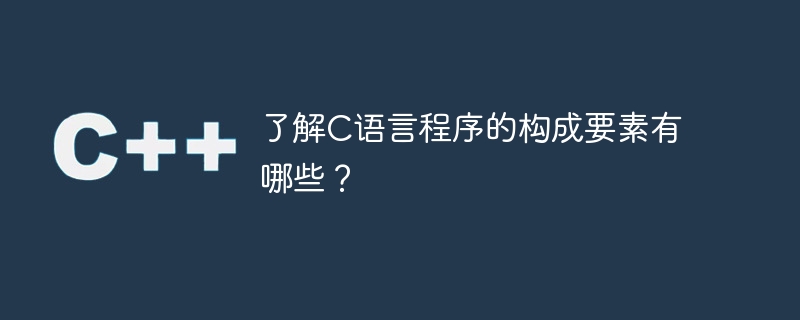Home >Backend Development >C++ >What are the components of a C language program?
What are the components of a C language program?
- PHPzOriginal
- 2024-02-19 17:58:061443browse

Understand what are the components of a C language program?
C language is a high-level programming language that is widely used in program development. In the process of learning and mastering C language, it is very important to understand the components of C language program. This article will introduce the components of a C language program to help readers have a further understanding of the C language.
- Comments
Comments are text in C language used to explain the function of the code and provide instructions. Comments are usually not processed by the compiler and will not have any impact on the execution of the program, but for programmers, comments are very important and can help them understand and maintain the code. Comments in C language come in two forms: single-line comments (starting with "//") and multi-line comments (starting with "/" and ending with "/"). - Preprocessing directives
Preprocessing directives are instructions processed by the preprocessor before the program is compiled. Preprocessing directives can be used to introduce header files, define macros, perform conditional compilation, etc. The syntax of preprocessing instructions starts with "#" and is usually written at the beginning of the program. - Function
Function is the basic organizational unit of C language program. A function is a block of code that can be executed independently to accomplish a specific task. C language programs usually contain multiple functions, one of which is the main function (main function), which is the entry point of the program. The definition of a function includes function name, return type, parameter list and function body. The function can return a value or no value (void type). - Variables
Variables are an abstract concept used to store data. There are many types of variables in C language, such as integer, floating point, character, etc. Variables need to be defined before use, and can be assigned an initial value during definition. Variables in C language have the concepts of scope and life cycle. The scope determines the visible range of the variable in the program, and the life cycle determines the storage time of the variable. - Expressions and operators
Expressions are composed of operators and operands. Operators in C language include arithmetic operators, relational operators, logical operators, etc. Common arithmetic operators include , -, *, /, etc. Common relational operators include >, - Control statements
Control statements are used to change the execution flow of the program. C language provides a variety of control statements, such as conditional statements, loop statements, selection statements, etc. Conditional statements (if statements) determine whether to execute a certain piece of code based on the true or false condition; loop statements (for statements, while statements) can repeatedly execute a certain piece of code; selection statements (switch statements) select execution based on the value of an expression. code block. - Array
An array is a collection that uses multiple variables of the same type to store a set of data. Arrays are very commonly used in C language and can be used to store a set of numbers, strings, etc. Elements of an array are accessed through subscripts, starting from 0. - Structure
Structure is a user-defined data type used to store multiple different types of data. A structure consists of multiple member variables, and each member variable can have different types. Through structures, multiple related variables can be encapsulated together for easy management and use. - File Operation
C language provides a wealth of file operation functions for reading and writing files. File operations are an important way to exchange data between programs and the external environment. Using file operation functions, you can open and close files, read and write files, etc.
The above are the main components of a C language program. Understanding these elements can help readers better understand the characteristics and usage of C language. At the same time, an in-depth understanding and mastery of these elements is also crucial to writing efficient and reliable C language programs.
The above is the detailed content of What are the components of a C language program?. For more information, please follow other related articles on the PHP Chinese website!

